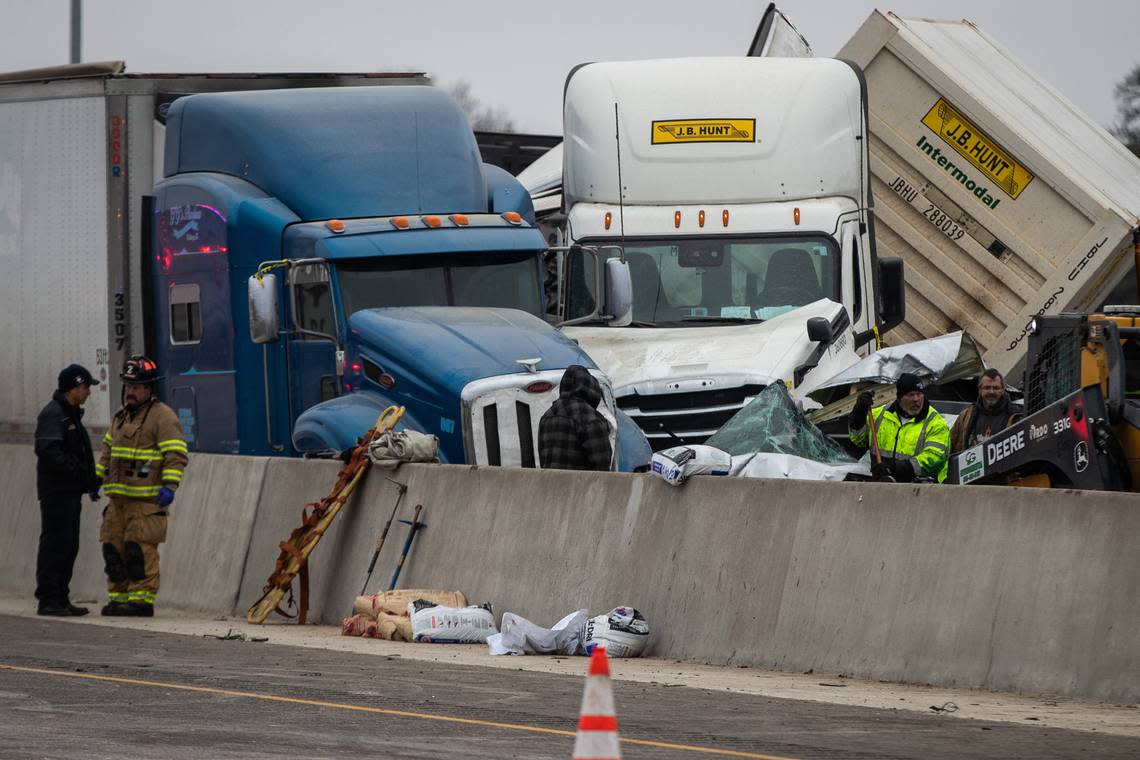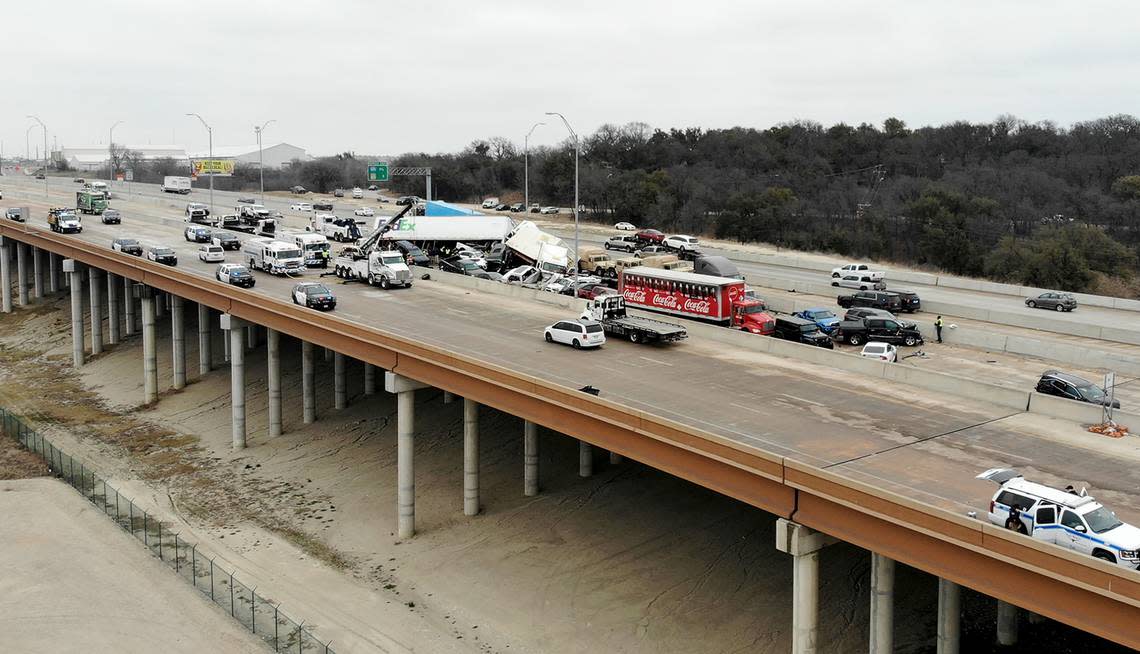Toll company failed to monitor, address icy highway before deadly I-35W pileup, feds find
A company’s failure to effectively monitor and treat icy roads and speeding contributed to a February 2021 pileup crash on Interstate 35W in which six people were killed, according to a report released Thursday from the National Transportation Safety Board.
The 130-vehicle collision occurred around 6 a.m. Feb. 11, 2021, on an icy patch of southbound TEXPress lanes near Northside Drive in Fort Worth.

The private company North Tarrant Express Mobility Partners built the roads and is responsible for treating the roadway for ice.
A spokesperson for the company said in a statement that the company has reviewed the final accident report and is disappointed and strongly disagrees with certain conclusions.
“Given the extraordinary circumstances, we are confident in the actions taken by the company,” spokesperson Robert Hinkle said. “In particular, we want to reaffirm that we fully activated our winter storm program leading up to and throughout the winter storm event, and that we coordinate with TxDOT on best practices for snow and ice control in North Texas.”
State Rep. Ramon Romero, whose district includes the crash site, said the report confirmed that the road was unsafe.
“It’s proven what we already knew, that they didn’t do enough,” he said.
Sen. Kelly Hancock, a North Richland Hills Republican whose district includes the crash area, said it is clear the company’s monitoring of road conditions failed and must improve.
“NTE should take immediate action in keeping with the report’s findings as the Legislature considers additional oversight options,” he said in a written statement.
Treating roads for ice
The National Transportation Safety Board found that the lanes had been treated for ice with a brine solution 44 hours before the crash, according to a in a preliminary report released in April 2021. The company’s pretreatment of the road was “reasonable” and followed state and federal guidelines, according to the final report.
But the monitoring process was deficient because the company did not detect that an elevated section of I-35W needed additional deicing treatment when rain arrived the morning of the crash, according to NTSB.
NTSB found that Mobility Partners’ employees mostly used visual observation, brake checking and handheld thermometers to detect ice and moisture on roads.
“Greater deployment and use of environmental sensor stations, used widely nationwide, would enable more efficient detection and monitoring of roadway conditions, as well as better responses to environmental events, likely reducing crashes and injuries during inclement weather,” a summary reads.
In the time since the crash, the company has installed installed 18 weather sensors in the Dallas-Fort Worth area, including within a half mile of the crash site, according to the report. The sensors, “strategically placed on elevated structures,” monitor air temperatures, pavement temperature and relative humidity.
The board also found that employees received insufficient training on monitoring road conditions during winter weather. Even with the sensors, roadway motoring is vital, the report says.
Mobility Partners’ employees receive annual training on monitoring roads during its “Snow and Ice Rodeo,” according to the report. But employees gave conflicting accounts of whether methods for checking roadways for moisture or ice were addressed.
“This training did not clearly emphasize roadway monitoring techniques to all participants,” the report reads.
Romero, a Democrat and member of the House Transportation Committee, has filed legislation requiring that toll road operator employees have training on treating roads for ice and snow that’s the same or substantially the same as Texas Department of Transportation employees.
North Tarrant Express Mobility Partners responds to NTSB findings
Hinkle defended the company’s treatment of the road for ice.
“Specifically, and as noted in the NTSB report, we pretreated the corridor well within the prescribed pretreatment window and during the storm, and our crews monitored the entire length of the I-35W corridor, including elevated areas to identify any potential ice formation,” he said in the statement.
Hinkle continued that crews patrolled in trucks with salt to deice and test the highway around the clock. Its technicians drove through the area of the accident within 45 minutes of the first indication of rain.
“We pretreated all sections of I-35W — as well as the rest of the 40 miles of highway corridors we operate and maintain in North Texas.” Hinkle wrote. “In addition, our technicians patrolling I-35W did not observe any previous precipitation at the accident location within 45 minutes of the first indication of rain in the incident area.”
Video footage from the morning confirmed that precipitation began minutes before the accident unfolded, he wrote.
“Hours earlier, we had posted dynamic signage within the vicinity of the accident site, warning drivers of icy conditions and to drive with caution,” he wrote. “We also had deployed permanent signage warning drivers that bridges could ice in cold weather.”
According to a document released in January, signs 1.9 miles and 3 miles from the crash site indicated that bridges may ice in cold weather and dynamic message signs warned of ice on roads. The dynamic message sign nearest to the crash site was 2.3 miles north at the Long Avenue on-ramp and visible to southbound drivers, according to the report.
Romero said the elevated area should have been prioritized.
“We knew how bad that freeze was going to be,” Romero said. “To think that they were driving around and inspecting the roadway, not immediately just going ahead and prioritizing all the elevated section makes no sense.”
Since the crash, Mobility Partners has increased the number of fleet vehicles equipped for winter maintenance and upped its salt storage capacity by more than 400 tons. They’ve added a new weather forecast vendor that offers more localized information, equipped all maintenance vehicles with infrared thermometers and devices that aid in capturing pavement temperatures.
They’ve also updated their training material to included the new technologies and processes, and added an online training for winter weather road maintenance, according to the report.
Driver speed
The board also found that speeding contributed to the crash.
A report from Mobility Partners released by the NTSB in January found the average vehicle speed on I-35W 15 minutes before the collision was 65 mph in the right lane and 82 in the left. At one point less than 15 minutes before the crash, speed in the left lane topped 100 mph.
“Finally, we found that, had drivers been traveling slower, they would have had more time to react and possibly avoid the crashed vehicles ahead,” the NTSB said in a summary of its report. “Reduced speeds would also have lessened the severity of the crashes once the vehicles began to slide on the icy road. Had technologies such as variable speed limit signs and speed safety cameras been used, drivers might have been more likely to slow to a speed appropriate for the conditions.”

Other documents made public in January included transcripts of witness interviews, a meteorological report and photos from the crash area. The documents released in January did not draw a conclusion about the cause of the crash.
The board found that the probable cause of the crash was ice accumulation on the elevated part of the road causing drivers to slide into other vehicles and road barriers. Ineffective monitoring for ice and speeding were contributing factors.
The design of the road
Romero has previously called for changes to the design of the stretch of road where the crash occurred.
The section of road separates tolled lanes and general use lanes with concrete barriers that don’t allow vehicles to pass through. The left barrier is 42 inches high and the right is 36 inches. The tolled lanes are about 24 feet wide with left-paved shoulder that’s roughly 4 feet wide and a right shoulder that’s about 10 feet, according to the report. There’s a 3% slope going up and down the elevated part of the road.
NTSB found that the roadway’s design in the crash area, including its slope, met applicable standards. But Romero was disappointed to see not see recommendations related to its design. He’d like to see pylons separate traffic instead of concrete, allowing vehicles to exit.
Romero said he believes that if the 42 inch divider wasn’t there, lives may have been saved.
Recommendations after fatal crash
NTSB outlined three recommendations for Texas.
▪ Texas should develop a statewide plan to install environmental sensor stations at priority locations to allow for a timely response to hazardous roads during bad weather.
▪ Texas should offer a “comprehensive winter weather training program” for toll road entities.
▪ The Texas Legislature should pass legislation that let’s TxDOT install variable speed limit signs on roads. The signs can change the speed limit based on traffic congestion and dangerous weather, according to the Texas A&M Transportation Institute.
Rep. Terry Canales, an Edinburg Democrat who chairs the House Transportation Committee, has filed a bill that would allow for the variable speed limit signs.
Texas Gov. Greg Abbott was not available for an interview Thursday afternoon. His office directed the Star-Telegram to TxDOT for comment.
In a written statement, TxDOT spokesperson Shawna Russell said safety is the department’s top priority.
“The department appreciates the careful and thorough work of the NTSB in looking into this tragic incident and NTSB’s recommendations that could help reduce the risks for motorists during winter weather condition,” the statement reads. “TxDOT continuously improves its winter weather operations, and the department has begun to carefully review the analysis and recommendations. TxDOT will specify further steps to be taken in the department’s response to the NTSB.”
This is a developing story. Check back for updates.
